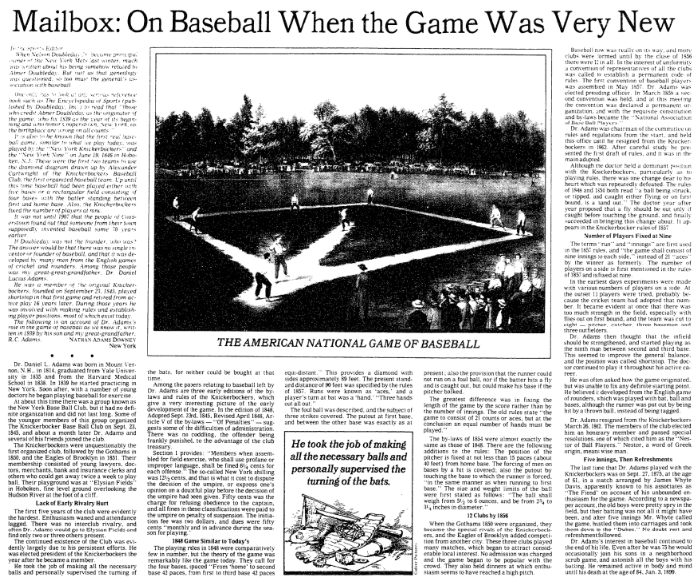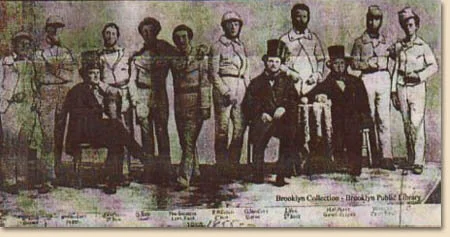0202 - Marjorie Adams
Marjorie Adams is the great-granddaughter of Doc Adams, who wrote The Laws of Base Ball in 1857 which set many of the primary rules of the sport still followed to this day. He also invented the position of Shortstop during his playing career. During our conversation, Marjorie referenced a handful of things and people upon which you may want to do more research. Consider this page to be your “liner notes” for the episode so you can follow along.
Marjorie Adams and me, recording our interview. Photo courtesy of Sam Rubin.
Gilbert & Sullivanl
William Gilbert and Arthur Sullivan made musical theatre a key part of popular culture in Britain and America. They created 14 works together, including The Sorcerer, which was their first full length project. Its premiere was held November 17, 1877 in London.
Daniel Adams
Doc’s father, Daniel Adams, was a noted physician, textbook author, and state legislator.
Adams compiled or wrote several different textbooks over the course of his life, including The Medical and Agricultural Register, which was published in 1807.
Geography; or, A Description of the World
First published in 1814, it was a pretty thick geography book for someone who never traveled west of Buffalo, New York.
The Scholar's Arithmetic
Originally published in 1801, the text was very popular during the first quarter of the 19th century. He published a revision of it, entitled Adams’ New Arithmetic, in 1827.
Doc Adams
Daniel Lucius "Doc" Adams is the hero of our story. This photo of him was taken around 1870.
New York Times
In 1939 R. C. Adams wrote a memoir of his father. Unpublished in his day, it appeared in the April 13, 1980 New York Times, along with a letter to the editor by R. C. Adams’ great-grandson, Nathan Adams Downey.
Baseball In The Garden of Eden
Major League Baseball Official Historian John Thorn’s 2011 book draws on original research to tell how the game evolved from other bat-and-ball games and gradually supplanted them, how the New York game came to dominate other variants, and how gambling and secret professionalism promoted and plagued the game.
Buy it HERE
Abner Doubleday
Abner Doubleday was a career United States Army officer and Union major general. He fired the first shot in defense of Fort Sumter, the opening battle of the Civil War.
In 1908, fifteen years after his death, Doubleday was declared by the Mills Commission to have invented the game of baseball (a claim never made by Doubleday during his lifetime). This claim has been thoroughly debunked by baseball historians.
Cornelia Cook
Doc and Cornelia Cook were married in 1861, and remained together until Doc’s death. The couple had five children; the first, a son named Charles, died less than a month after his birth in 1864. The others, two sons (Frank and Roger) and two daughters (Catharine and Mary), were born between 1866 and 1874.
1881 Yale Autobiography
This collection of autobiographies, gathered and published 50 years after the Class of 1835 was admitted to the college, featured a write up by Doc.
1881 Autobiography
Part one of Doc’s entry is shown here.
1881 Autobiography (cont.)
Part two of Doc’s entry is shown here. The quote Marjorie gives is from point 8.
The Bat and Ball Letter
On June 15, 1832, Doc received a letter from his 11-year old sister.
The Pittsfield “Baseball” Bylaw of 1791
In 2004, officials and historians from Pittsfield, Massachusetts uncovered a document which they believe is the earliest written reference to baseball.
Henry Ward Beecher
Henry Ward Beecher was an American Congregationalist clergyman, social reformer, and speaker, known for his support of the abolition of slavery. He also liked to play the flute with Doc Adams, for which he is not quite as well known.
Walter T. Avery
Walter Avery was born in 1814 and graduated from Columbia in 1836. His first appearance with the Knickerbockers was on April 14, 1846, but his membership lasted only a few years. In 1850, he, along with a number of other Knickerbockers, headed west to seek their fortunes panning for gold. He passed away in 1904 at the age of 90, at which time he was the last living member of the original Knickerbocker ball club.
Knickerbocker Base Ball Club
The Knickerbocker Base Ball Club formally organized on September 23, 1845. Doc Adams joined the club about a month later.
Madison Square Park
The southwest corner of Madison Square Park (here, in 1860) is where America’s pastime got its mid-19th century start.
How Baseball Happened
One of the best baseball books of 2020 is this one by Tom Gilbert, which talks about how baseball really got its start.
The Other “Doc” Adams
Hugh Milburn Stone was an actor best known for his role as "Doc" (Dr. Galen Adams) on the CBS Western series Gunsmoke.
Doc’s Website
You can find tons of great information on the website dedicated to Doc:
docadamsbaseball.org
Elysian Fields
The Elysian Fields was parkland located on Hoboken's northern riverfront and stretched roughly from present day 9th to 12th Streets and from Washington Street to the Hudson River.
June 19, 1846
Doc played in the Knickerbocker Base Ball Club’s first “Official” game at Elysian Fields.
The Great Black Swamp Frogs
The Vintage Base Ball Club from Sylvania, Ohio
Fred Ivor-Campbell
Fred served as the chair of SABR’s 19th Century Committee from 1991 through 1998.
Lemon Peel Baseball
Similar to the style of ball Doc Adams was making for his teams, these are referred to as lemon peel balls because their stitch pattern mimics the cuts used to peel a lemon. Learn how involved of a process it is to make one by watching THIS VIDEO.
You can buy a replica lemon peel ball HERE.
Shortstop
What do each of these players have in common? They owe their careers to Doc Adams.
Gothams
While many other teams existed, it seemed the Knickerbockers were most fond of the Gothams and the Eagles.
The Laws of Base Ball
Penned by Doc Adams in 1857, the Laws of Base Ball outlined the rules and guidelines by which players and clubs would follow when playing in “match games of base ball.” Many of its proposed elemental rules, from setting base paths at 90 feet, to settling on nine players per team, to fixing the duration of the game at nine innings, owe their genesis to the document that was drafted during a convention of New York area baseball clubs in 1857.
Grenelle’s Laws
William Henry Grenelle was elected to membership in the Knickerbocker Base Ball Club on June 14, 1850. By 1857, he was Club Director. It is thanks to his copies of Doc Adams’ original laws that we know what all of the original rules were, even though one of the original Adams pages is missing.
1858 All-Star Match
On July 20, 1858, nearly 10,000 fans gathered to watch what was essentially the first All-Star Game in the history of baseball.
1859 New York Knickerbockers with NY Excelsiors panoramic photo (Doc Adams is 4th from left).
1846 Daguerreotype
Quite a controversial photo, this daguerreotype has been dissected and debated for years. Most scholars and historians have concluded it is not of the Knickerbocker Base Ball Club, and that Doc Adams is not pictured.
The Adams Home
In Ridgefield, Connecticut
Ridgefield Savings Bank
Doc became President in 1871, and would serve in that role for 10 of the next 15 years.
John Thorn
Since March 1, 2011, John Thorn has been the Official Historian for Major League Baseball. He has also attempted to shed light on the contributions of 19th century pioneers of the game, while debunking common misconceptions.
Marjorie Adams
Going to bat for her great-grandfather, Doc.
Up For Auction
The Laws of Base Ball went back up for auction in 2016, this time with the seller and bidders knowing exactly what they were.
Roger Ratzenberger
Roger has his own amazing website, but he also runs the Doc Adams website.
Knickerbocker Base Ball Club buttons
These buttons were most likely ceremonial for special occasions, similar to the stud buttons that would go into a collar of a band uniform or a military uniform.
Marjorie’s Mission
To get Doc Adams represented in Cooperstown, in memory of her father and her grandfather.
Just Short
Doc needed only two more votes in 2015 to have been elected to the Hall of Fame.
Help Marjorie, Help Doc
Some other websites I accessed while doing research for this interview with Marjorie Adams:
https://www.youtube.com/watch?v=8DptPsi5zRM
https://www.youtube.com/watch?v=fDsXr-e85Xw
http://www.columbiamedicinemagazine.org/features/fall-2016/medical-fellows-and-new-york-game
https://ourgame.mlblogs.com/the-baseball-convention-of-1857-a-summary-report-c6b63bee1ed3
https://docadamsbaseball.org/updatespress-releases-2/doc-in-the-media/marjorie-adams-interviews/














































